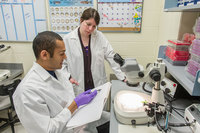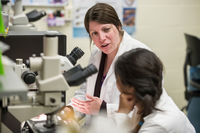Cilia's got the moves in the kidneys, researchers' work shows

Cilia are tiny, hair-like appendages that stick out from each of your cells. They can either move to propel fluid or remain stationary, acting as antennae to receive information from their environment. Most cells have just one cilium, but some are multiciliated cells (MCCs), which means…
Notre Dame biologist investigates genetics behind kidney development and regeneration

Rebecca Wingert, Elizabeth and Michael Gallagher Associate Professor in the Department of Biological Sciences at the University of Notre Dame, recently published findings in ELife that have revealed new insights into the genetic pathways that control kidney cell development.
What makes a good malaria vector?

Nora J. Besansky, the O'Hara Professor and Associate Chair in the Department of Biological Sciences, hypothesizes in a recent paper in the Proceedings of the National Academy of Sciences that if scientists can understand what makes a small group of Anopheles mosquito a strong malaria vector, then perhaps we can prevent the spread of disease.